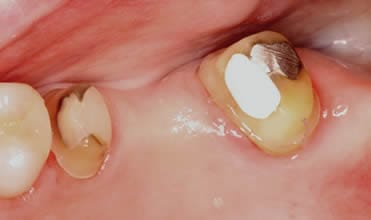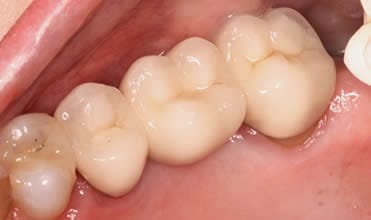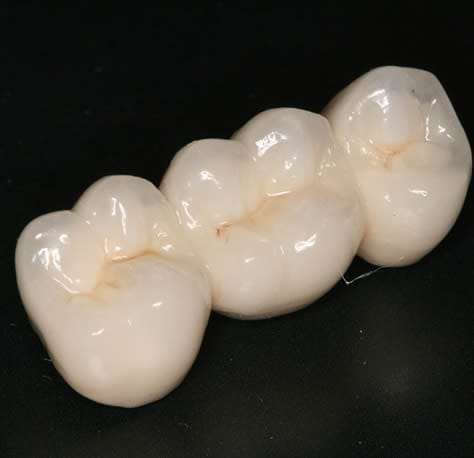What is a Bridge?
A Bridge is a restoration used to replace missing or lost teeth. It is fixed in place by cementing it to the teeth (or implants) adjacent to the space.
What is a Bridge made of?
There are several types of bridge available, each with its own advantages, disadvantages, and cost. Generally speaking, a bridge can be either:
- porcelain bonded to a metal substructure
- all ceramic
Your dentist will discuss with you the best options, but you will have the final say on what you want, having weighed up all considerations.
Is there an alternative to a Bridge?
Missing teeth can be replaced by other means, namely:
- a denture
- implant-supported crowns
- or, alternatively, the space can be left unrestored.
What are the advantages of a Bridge?
A bridge is a fixed restoration, so it cannot be removed. It looks, and functions, just like natural teeth
What are the disadvantages of a Bridge?
The supporting teeth usually need to be prepared, i.e. shaped so that the bridge can fit over them. This may involve the removal of natural, healthy, tooth tissue. A bridge restoration will not last forever - it may need periodic replacement as it subjected to wear and tear.
How is a Bridge restoration carried out?
The supporting teeth will be prepared, usually under local anaesthetic, to a specific shape which will allow the bridge to fit over them without making the teeth too bulky. Impressions will be taken of both the upper and lower jaws so the technician can make the bridge on a complete set of models of your teeth. This will allow the technician to shape the bridge correctly so that it matches the rest of your teeth and functions properly.
 Before treatment
Before treatment
 During treatment
During treatment
 After treatment
After treatment
How long will the treatment take?
A bridge restoration will typically need two appointments. The first appointment will be for preparation of the teeth that are to be used to support the bridge, and impression taking. This appointment will be about 1 to 2 hours long. You will usually have temporary crowns fitted to the prepared teeth to keep them protected and functioning for the 2-3 weeks before your second appointment. The second visit will usually be for 30 minutes. At this appointment, your dentist will remove the temporary crowns and check the new bridge for correct fit, appearance, and function. The bridge is cemented to your teeth and you will be given appropriate advice on maintenance.
Sometimes a supporting tooth may be very broken down and require additional support for the bridge in the form of a post. If any tooth requires a post to help support the final bridge, you may need additional appointments for the making and fitting of the post.
How is the Bridge attached to my teeth?
The bridge is cemented using a special cement which bonds the bridge to the teeth. This cement is strong enough to allow you to use the bridge for normal chewing.
Is the treatment painful?
A bridge procedure is not a painful process. Local anaesthetic will be used to numb the supporting teeth while they are being prepared for the bridge and again when the bridge is being fitted. Some patients report a mild sensitivity in the teeth after the preparation appointment.
Are there risks associated with having a Bridge?
A bridge is an extensive restoration often requiring significant preparation of the supporting teeth. As with all extensive restorations, there is a risk that the nerve in the supporting teeth will eventually die, sometimes many years after the bridge is fitted. It is estimated that 12% off all teeth prepared for a bridge will eventually feature nerve death leading to the need for either root canal therapy or extraction.
How long will my Bridge last?
No dental restoration lasts for ever. Any restoration is a compromise to natural healthy tooth structure. A bridge restoration will typically last 10 - 15 years, provided it is looked after by you, the patient, in terms of cleaning and avoiding high risk factors for dental disease. If and when the bridge fails, a new bridge can usually be fitted.
Will my Bridge look natural?
Your dentist will match the bridge to the adjacent natural teeth as closely as is possible. When dealing with a front tooth, it may be impossible to match the colour of the bridge to the adjacent natural teeth exactly. This is because porcelain is a different material to natural enamel, with different light-reflecting properties. Modern dental ceramics, however, have made colour matching much more predictable, and the bridge should not be obvious when fitted. In addition to this, we often use digital photography to aid in relaying important information about the shape, colour, and position of the teeth to the technician. Sometimes we even arrange for the patient to visit the technician’s laboratory so that he can see the adjacent natural teeth and mimic them for optimal results.

